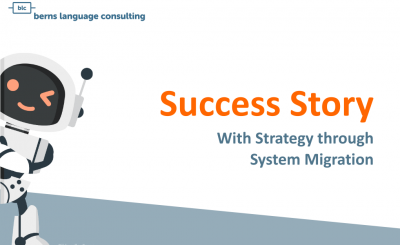The blc Data Toolkit - our software kitchen
What is the blc Data Toolkit? The real answer to this question is very technical. It can, however, be turned into a nice, humorous abstraction.
The geeky and somewhat boring answer is that the Data Toolkit is a so-called “framework”, that is a “programming structure”, in which code is collected in a structured way (cf. Duden 2025). Our framework is written in the programming language Python. It allows us to provide our clients with our services.
The more entertaining answer to the question what the Data Toolkit actually is, is an analogy…
Code à la carte – this is how we "cook up" our services
If blc was a restaurant, then we – the computational linguistics team – would be the cooks, and the Data Toolkit would be our kitchen.
Why? Well, in a restaurant kitchen you’ll find various drawers and cupboards with the utensils needed to prepare the dishes on the menu. This is also the case with our Data Toolkit. It contains numerous collections of functions and methods, so-called modules, which we use to process data in different ways. We fall back on certain methods almost every day, similarly to how you grab a knife or bowl for cooking and baking most days. Other methods are custom-made, specifically for our clients. Think of something like an apple corer or an asparagus pot. You rarely use them, but they save you a lot of work when you do need them.
When a company hands over their data to us, it is as if they are bringing us a box of ingredients. We then discuss with the client what we will “cook” and collect the necessary utensils in our kitchen.
The "blc Menu"
Now we understand that the Data Toolkit is nothing more than a bunch of kitchen gadgets, let’s take a look at what Sophia and I can whip up with these utensils. Our services can be divided into three major blocks: Terminology-, TM– and AI-related services.
Our "Starters"
Using the “Analysis” module of our toolkit, we can examine terminology and translation memory data and point out problems as well as potential to our clients. We pay particular attention to the data quality, by, for example, determining how many duplicates we can find. An analysis is a good way to get a first overview and whet the appetite – the perfect “starter”!
Available in savoury and in sweet
Once the problems have been detected, we can also help resolve them. To do this, we pick some tools from the “Term Modification” or “TM Modification” drawer and edit the data according to our client’s wishes. This works like a pick ‘n’ mix: The client can put together their own dish by choosing which structural or content changes should be made to the data. Depending on whether we already have the right kitchen tools to carry out the modification or not, this can very quick and simple or take a little longer. In any case: If the result fits the bill, it is worth the effort, since preparing your dream meal without a well-equipped kitchen is hard!
Craving something fresh?
Don’t have much (terminology) data? No problem! We will reach into our “term extraction cupboard” and collect new terminology from domain-specific texts, preparing the terms in a way that will make your mouth water. On request, we can deliver the results directly into the target system.
Yummy, cake!
Want to move from one system to another? Whether as a dessert or a little snack: We can migrate data into a new system with as little information loss as possible – that is, no crumbs!
Want something to drink?
We are happy to advise and support you on AI-related topics! This applies to the stages before and after training a model. For example, we can prepare training and test data sets and help with the planning and implementation of the model evaluation. The AI type and the specific use case do not matter for us. Whether “classic” MT, QRE, LLM or something else: Don’t hesitate to contact us and we will prepare your beverage according to your wishes! Not sure yet what is best for you? As part of “tastings”, we can also try and compare different AI models for you and give you an overview of your options.
Conclusion: Cooking Up Data Delicacies
Whether it’s a star-worthy dish or cozy home cooking – with the blc Data Toolkit, we have the right recipe for every data appetite. Our kitchen gadgets make life easier, whether we’re cooking up fine terminology tarts, refining translation memory delicacies or experimenting with AI cocktails.
And when a entirely new special is needed? We’ll just come up with a novel creation together! In our kitchen, there are no ready meals – only tailor-made, data-processing delicacies. Bon Appétit!










